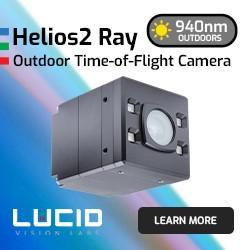R&D Strategy: Panasonic Introduces New Robotic Applications – Join the YouTube Livestream
Customers expect turnkey solutions from one supplier. During the YouTube event, the company will present examples from leading B2B customers in Europe, e.g. an automation solution developed for an automotive supplier’s factory in Germany.
Panasonic will announce its R&D strategy for its next generation of robots. Based on its broad expertise in sensor as well as drives technology, and derived from its experience in industrial robots, Panasonic will tackle the needs of aging societies - from healthcare add-ons to labour shortages in retail and logistics.
The company's focus is on pragmatic solutions that work with people, and this can be defined within three core pillars: augmented solutions, stand-alone solutions, and complete robotics automation solutions. Panasonic will introduce six robot models, aligned with its new Robotics strategy, during a YouTube event free for anyone to join on:
17th of December, 3pm CET
https://youtu.be/aXgn1Ci46D0
Customers expect turnkey solutions from one supplier. During the YouTube event, the company will present examples from leading B2B customers in Europe, e.g. an automation solution developed for an automotive supplier's factory in Germany.
Utilizing the Advantage in Industrial Robots & Sensory
Panasonic is a tier-one producer of industry robots due to its inhouse development of sensors and drives. The company predicts that the general market trends in the components sector such as the focus on miniaturization, the combination of multiple intelligent sensors in one device, and the reduction of mass, will enable new applications to be explored.
Johannes Spatz, President of Panasonic Industry in Europe comments, "We believe the knowledge and technology in these areas, along with our know-how in industrial robots, prepare a reliable and tested pathway for successful applications of robotics in other areas."
One of the examples highlights the transfer of industrial applications to the healthcare industry through the use of lidar sensors within delivery robots that had originally been developed for automated guided vehicles in production sites.
Academic Partnerships & Open Source Solutions
Central to the new strategy, Panasonic has established joint offices and is collaborating with eight universities - two in Europe and six in Japan. Among the partnerships in Europe are those with the Technical University in Munich, Germany, and the ETH in Zurich, Switzerland. Takeshi Ando, head of the Global Robotics R&D activities at Panasonic summarizes: "Panasonic has evolved from pushing proprietary systems to an open technology platform. The new platform combines elemental technologies such as sensing, system integration, planning and computing, locomotion, object handling, communication and power source and battery."
For more information about Panasonic Robotics visit: https://www.panasonic.com/uk/corporate/sustainability/smart-cities/robotics/
About Panasonic
Panasonic Corporation is a global leader developing innovative technologies and solutions for wide-ranging applications in the consumer electronics, housing, automotive, and B2B sectors. The company, which celebrated its 100th anniversary in 2018, operates 528 subsidiaries and 72 associated companies worldwide and reported consolidated net sales of 61.9 billion Euro (7.49 trillion yen) for the year ended March 31, 2020. Committed to pursuing new value through collaborative innovation, the company uses its technologies to create a better life and a better world for customers. To learn more about Panasonic: https://www.panasonic.com/global.
Featured Product

Helios™2 Ray Time-of-Flight Camera Designed for Unmatched Performance in Outdoor Lighting Conditions
The Helios2 Ray camera is powered by Sony's DepthSense IMX556PLR ToF image sensor and is specifically engineered for exceptional performance in challenging outdoor lighting environments. Equipped with 940nm VCSEL laser diodes, the Helios2 Ray generates real-time 3D point clouds, even in direct sunlight, making it suitable for a wide range of outdoor applications. The Helios2 Ray offers the same IP67 and Factory Tough™ design as the standard Helios2 camera featuring a 640 x 480 depth resolution at distances of up to 8.3 meters and a frame rate of 30 fps.
